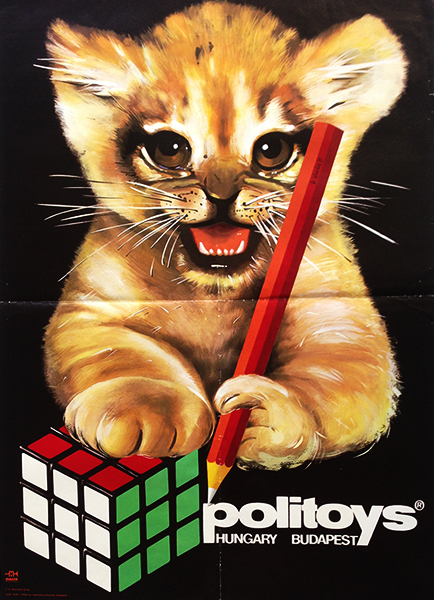
Description:
Poster advertising Politoys, a toy producer company. Politechnik (later Politoys) was known for producing the world famous Rubik's Cube. Rubik's Cube was first called the Magic Cube (Bűvös kocka) in Hungary. The first test batches of the Magic Cube were produced in late 1977 and released in Budapest toy shops. In September 1979, a deal was signed with Ideal to release the Magic Cube worldwide, and the puzzle made its international debut at the toy fairs of London, Paris, Nuremberg and New York in January and February 1980.
After its international debut, the progress of the Cube towards the toy shop shelves of the West was briefly halted so that it could be manufactured to Western safety and packaging specifications. A lighter Cube was produced, and Ideal decided to rename it. "The Gordian Knot" and "Inca Gold" were considered, but the company finally decided on "Rubik's Cube" (referring to the inventor of the game, Ernő Rubik), and the first batch was exported from Hungary in May 1980. (source: wikipedia.org)
The design of the poster bears the typical characteristics of Wanda Szyksznian's art: painting like imag, intensive colour scale and a photo-like, detailed drawing style. The black background adds deepness to the composition. The lion cub catches attention and carries multiple meanings. It puts its 'hand' on the cube implying that he won't give it to anyone. It suggests that the game is addictive. However, the lion is still a baby, what let's the viewer assume that it is for all age groups. With the other 'hand' the lion is holding a pencil and writing the manufacturer's name on the poster, hence the audience understand that it must be an intelligent animal, and Rubik's Cube is not just a toy, but playing with it requires serious brain work therefore contributes to the player's intellectual improvement. The cube is done, the colourful squares are put to their places and they show the colours of the Hungarian flag: red, white and green. The poster was made one year after the export of the cult toy and it made the locals very proud of it. It wasn't common in the time of Socialism that a product designed in Eastern-Europe was being sold in Western countries with a huge success. This pride is reflected in every bit of the poster.











